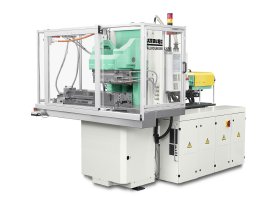Jun 2 2008
There is a newcomer to the Allrounder V series: another larger model of this special, vertically operating machine was introduced at the Technology Days. The Allrounder 375 V rounds off the upper clamping force range of this series. All three available sizes was put through their paces at the Technology Days: from the small Allrounder 175 V with a clamping force of 125 kN, through the medium-sized Allrounder 275 V with a clamping force of 250 kN to the largest model, the Allrounder 375 V with a clamping force of 500 kN.
 The new Allrounder 375 V with a clamping force of 500 kN was introduced at the Technology Days and rounds off the upper clamping force range of the ver-tical machine series with free-space system.
The new Allrounder 375 V with a clamping force of 500 kN was introduced at the Technology Days and rounds off the upper clamping force range of the ver-tical machine series with free-space system.
Another highlight in this context was the use of the new Exjection® process on the new machine. This process was developed by IB STEINER and Hybrid Composite Products GmbH in Spielberg, Austria. Exjection® can be used to produce long, thin-walled and structured components from viscous thermoplastics. End caps and functional geometries can be formed with the profile.
Exjection® offers special benefits when combined with the Allrounder V free-space system
Arburg machine and control technology offers some decisive advantages when Exjection® is used on Allrounders. Because of the low clamping force required, the process is particularly suited to the vertical Allrounder V models. One of the main reasons for this: because the mould is installed horizontally, the transfer movement during the injection process is also horizontal. Thus, this design puts no limit on the mould length, stroke, or component length. The open design of the free-space system means that it is very easy to reach inside the mould to remove parts. In addition, the connection to the Selogica control system offers further potential for optimising the injection moulding process. This means that the integration of servo-electric drives - for example to move the mould forward in conjunction with a servo-controlled injection movement - enables the process to be coordinated even more effectively.
How does the Exjection® process work?
While the melt is being injected into the mould, the formative cavity is moved across the longitudinal axis of the machine. The moving cavity is gently filled with the flowing melt. A pressure profile is formed in the resulting component, ensuring a defined melt density and at the same time providing for the necessary holding pressure. Exjection® technology is characterised by a freedom from joint lines and low level internal stresses along the entire length of the component. This means that large dimension parts can be produced on injection moulding machinery with low clamping forces, minimising processing pressures and significantly reducing manufacturing costs.
Arburg has many years of experience
When it comes to linear mould filling, Arburg is also one of the pioneers in the injection moulding industry. The company continues to pursue this approach through linear injection in the parting line or the Arburg Vario system. The Vario system allows the injection unit to be moved horizontally from the centre, enabling long parts to be filled in a linear process without any need for complex sprue designs.
New technology on the new Allrounder
During the Technology Days, Exjection®-technology was demonstrated on the newest and biggest member of the V family, the Allrounder 375 V with a clamping force of 500 kN. Injection unit sizes 100, 170 and 290 can be used on this machine, although the demonstration model was fitted with the largest injection unit. The maximum shot weight on the 100 injection unit is 65 g PS, while that on the 170 unit is 105 g PS and on the 290 unit 172 g PS.
All hydraulic Allrounder V machines are characterised by their fixed vertical, down-stroking clamping units, designed as a free-space system. The fixed lower mould platen has major advantages when encapsulating insert components because these cannot become dislodged. As with all the other Allrounders, the whole machine series features a modular design and offers a variety of combination options. The injection units can be arranged horizontally or vertically. Injection is possible both centrally and in the parting line.
A control rail was moulded from ABS on the new Allrounder 375 V 500-290 with a weight of 50 grams and a cycle time of 60 seconds. As well as an electric dosage drive and an electric core pull, the machine is also fitted with a position regulated screw and the necessary Exjection® software. This configuration shows how Exjection® processes and vertical Allrounder technology can be combined with the Selogica control system for optimum results, achieving the perfect production of high quality moulded parts.